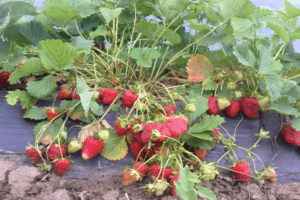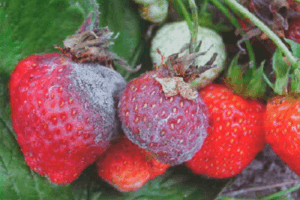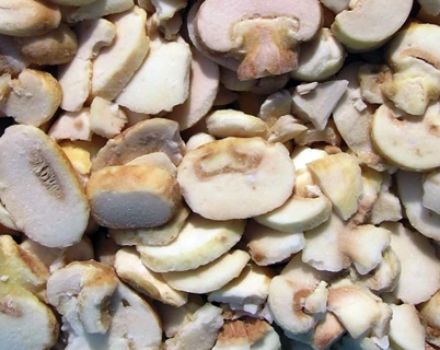Description and characteristics of the strawberry variety Tago, cultivation technology
Tago is a late ripening variety. Refers to high-yielding varieties. Strawberry fruits are juicy and sweet, will appeal to both adults and children. Grown for home use and for sale.
Variety characteristics
Gardeners attribute Tago to mid-season varieties, but more it is considered late. It survives the winter well, which is considered a big plus. The berries are dense, making transport easy. It is consumed fresh, suitable for cooking compote and jam.
Description of strawberry Tago
You can eat the fruits of Tago not earlier than the beginning of July. Bushes reach medium height, average foliage. The leaves are colored deep green. The increased formation of antennae promotes rapid reproduction. This allows the variety to be regularly renewed.
The berries that are harvested first from the bush have an elongated shape that looks like a cone. Strawberries harvested towards the end of the season are characterized by a rounded shape. Painted in the typical strawberry color - red.
By weight, the berries reach 30-60 g. A pleasant strawberry aroma emanates from them. The juicy pulp is of medium density. A slight sourness is felt during use. The section shows that the inside of the berry is red, which indicates full ripeness.
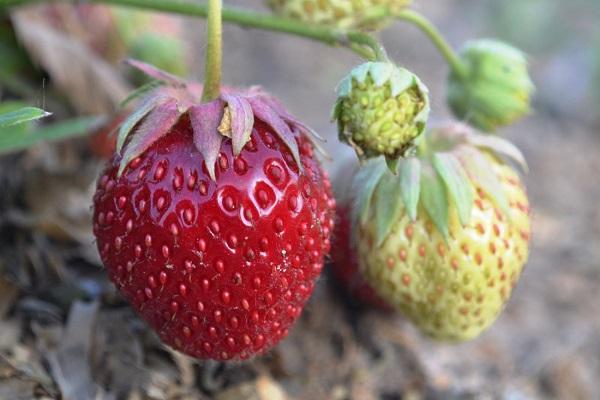
Main advantages and disadvantages
Tago strawberries are loved by gardeners because of their many advantages. The variety has the following positive qualities:
- It is characterized by high productivity.
- Suitable for growing in regions with cold climates. Therefore, it is appreciated for its winter hardiness.
- It is rarely affected by spider mites, bacterial and fungal diseases.
- Berries are not damaged when transported over long distances.
- It has an excellent presentation - a shiny surface, rich berry color, delicate aroma and strawberry flavor.
- A versatile variety for use.
Cons of Tago:
- Susceptibility to spotting.
- Late ripening period.
The late ripening period, on the one hand, can be attributed to the pluses. When the fruiting of the early varieties ends, the late berries begin to ripen. Thus, strawberries are enjoyed throughout the summer.

There are very few disadvantages, and against the background of the advantages, they seem insignificant.
The subtleties of growing
Before planting strawberries, it is worth examining the timing and soil requirements.
Planting time for garden strawberries
The standard dates are early spring and late autumn. In the latter case, the period lasts 3 weeks. It starts at the end of August and lasts until mid-September. But, according to gardeners, Tago, like other varieties, can be grown at any time of the growing season.
Planting in autumn is more recommended for southern regions. Strawberry seedlings have time to take root before winter. If the growing area has a cold climate, spring planting is carried out. Thus, the planted seedlings will safely survive the long winters.
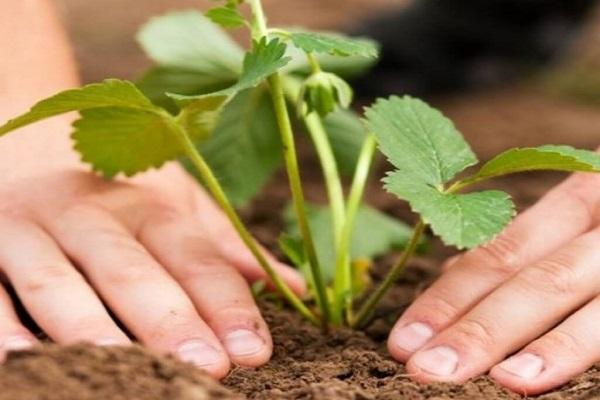
Preparation of planting material and planting sites
There are no special preparatory manipulations before disembarking. Young plants are used as they take root faster. Damaged and large seedlings are excluded.
There are also no special requirements for the location of the variety on the site. The place must be on the sunny side. In other words, it is very good when the Tago seedlings are in direct sunlight for most of the day. Otherwise, the ripening of the berries is stretched.
The constant presence of Tago in the shade reflects on the taste of the berries and not for the better. They become sour and also become smaller in size.
Suitable soil is black soil mixed with peat.

Disembarkation process
When planting a culture, the gardener is guided by only one thing — convenience. Tago allows you to independently select a scheme, taking into account the land plot. In this case, the distance between the bushes should not be less than 30 cm.
The holes are dug to a depth of about 25 cm. After planting, the strawberries are watered.
Soil saturation increases the chances of settling down and growing. If desired, the soil is mulched immediately after planting.
Strawberry care rules
The plant is not picky and requires a minimum of care procedures. The main thing is that they are regular. Do not forget about watering, weed removal and replanting.
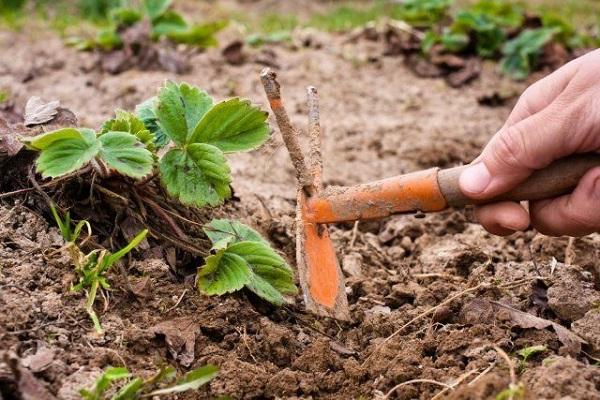
Irrigation scheme
The soil is saturated with moisture as the top layer dries. In dry, long weather, the procedure is repeated three times a day. Tago responds positively to sprinkling. At the time of the appearance of flowers, strawberries are watered at the root.
The need for watering is determined in another way. On strawberry beds, holes are dug 30 cm deep. And this is done in different places throughout the site.
Then examine the soil taken from the very bottom of the hole. If the soil in your hands crumbles when crushing, the strawberries need watering. In cloudy weather and cold summers, the amount of irrigation is reduced to 1 time per week. While pouring the berries, Tago is watered every 5 days.
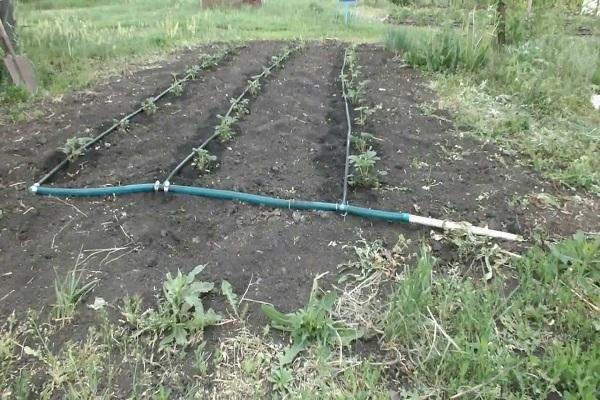
Fertilization
To support growth and fruiting, Tago is fed three times per season. The first fertilization is carried out after the snow melts. A complex of nutrients acts as fertilizers, which is applied in liquid form.
The second dressing should be root and should be done during flowering. Strawberries are watered with a mullein, previously filled with water. For 1 part of water, 6 parts of mullein are needed. At the end, the bushes are sprinkled with wood ash.
The third fertilization is carried out after the end of fruiting. Superphosphate is used. 50 g of the substance is dissolved in 10 liters of water, and the bushes are watered with the resulting liquid.
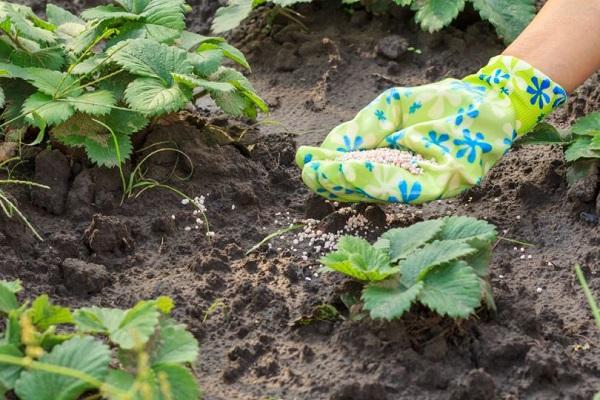
Mulching and loosening the soil
Mulch is a special layer that protects the soil from active growth of weeds. Thanks to the coating, moisture does not evaporate from the soil so quickly. Mulching makes it easier to care for your strawberry plantings. Peat, sawdust and straw are good mulch.
The soil in which strawberries grow requires regular loosening. The procedure is carried out after watering when the soil dries out.
Removing the crust on the surface is mandatory, as it prevents the soil from breathing.
Preparing for winter
Preparations begin in the fall. The bushes are carefully prepared before winter. Dry foliage, damaged parts and bad stems are removed.
If in the growing region winters are distinguished by low temperatures, duration and high rainfall, the culture needs reliable protection. The Tago site is taking cover. This can be a layer of mulch or other fixtures.
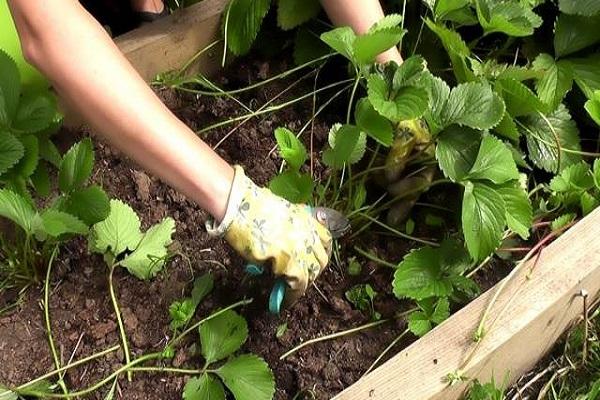
Agrofibre protects strawberries from severe frosts in snowless winters. The plant may die at the beginning of winter, since the snow does not have time to fall and cover the plantings from frost. In this case, peat, sawdust or the same straw will help well. Lapnik is also a good shelter for strawberry plantings.
Diseases and pests of garden strawberries
Tago received a strong immune system, but it is still not easy to protect herself from a number of diseases. Insects, fungi, and various microorganisms are the sources of diseases. Parasitizing on stems and foliage, they drink all the juices, due to which the plant becomes weak. Therefore, it is more difficult for the immune system to resist disease.
To exclude the likelihood of developing various diseases, strawberries are processed with various preparations. Processing products are purchased in specialized stores or prepared independently. The only condition that a person must observe when treating plantings is that processing is not carried out during the flowering of the culture..

Breeding methods
For breeding, use one of the proposed methods:
- seeds;
- dividing the bush;
- antennae.
The second and third methods are popular. The first is used in rare cases. Only professional gardeners or amateurs who want to understand what the method is, decide to plant strawberries with seeds.
The sprout obtained by one of the methods is planted according to the standard scheme. Tago is transplanted to a new location every 4-5 years. More strawberries do not grow on the site, which is confirmed by the appearance and yield.
Harvesting and storage
The fruits break off as they ripen, when they turn bright red. Plucked berries are stored in the refrigerator for 3 weeks. The dense pulp does not spoil for a long time, so strawberries can be sold.
